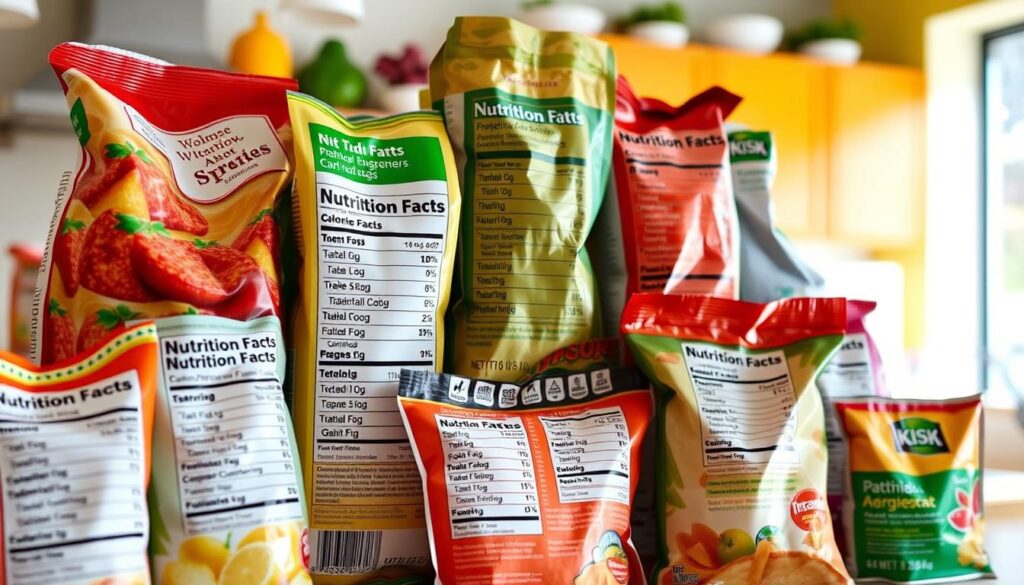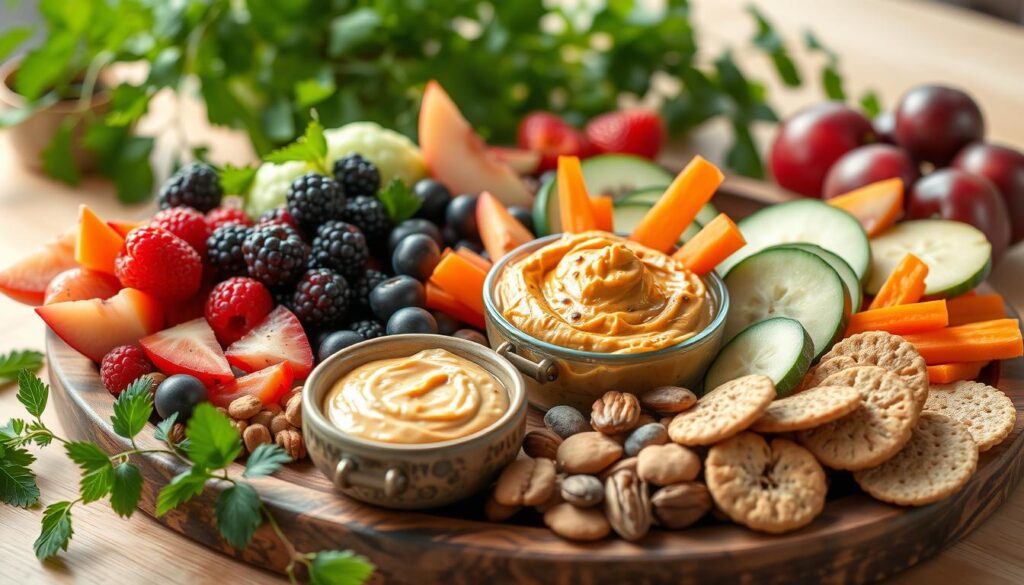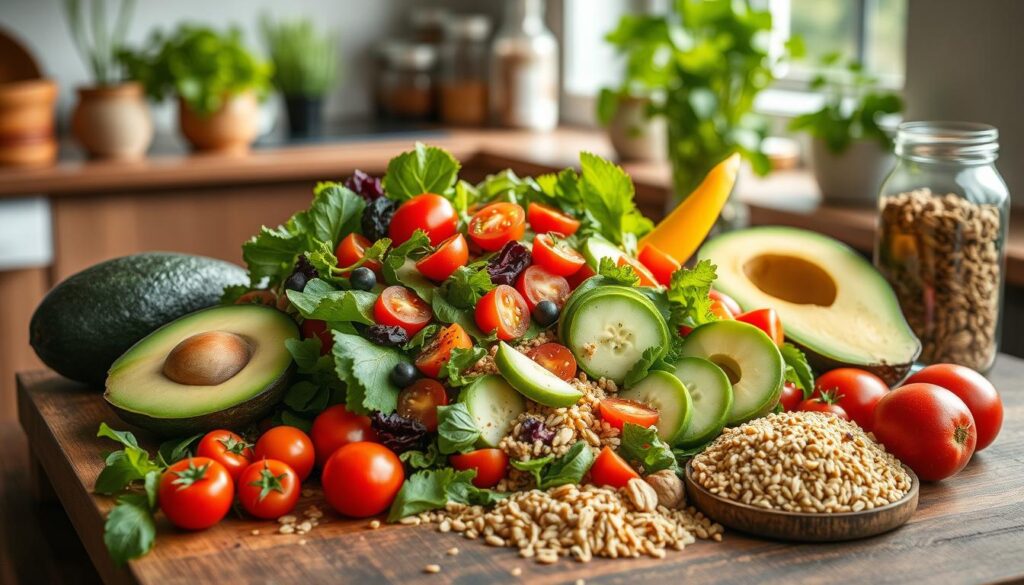היום, רבים מאיתנו מוצאים את עצמם בוחרים במזון מהיר ומעובד. אך ערך התזונה הבריאה עומד בפני עינינו יותר מתמיד. כל מי שמעוניין לשפר את בריאותו צריך להתמקד באכילת מזון תזונתי. מדריך זה יראה לך את יתרונות האכילה הטובה. המדריך משתמש במקורות אמינים כמו ההנחיות התזונתיות של משרד החקלאות האמריקאי וההמלצות של ארגון הבריאות העולמי. תלמד טיפים מועילים ותקבל מידע חשוב לבחירת מזון טובה.
מסקנות מרכזיות
- הבנת חשיבותה של תפריט מאוזן משפרת את הרווחת הכללית.
- מזון תזונתי מספק חומרים תזונתיים חיוניים לבריאות גופנית.
- אכילה בריאה היא גורם מרכזי בכל מסע טיפול בבריאות מוצלח.
- ידע בהנחיות תזונתיות עשוי לסייע בבחירות תזונתיות מושכלות.
- שינויים פשוטים בתפריט יכולים להביא לתועלות בריאות ניכרות.
חשיבותה של אכילה בריאה
לאכילה בריאה חשובה לשמירה על בריאות טובה. חשוב מאוד לאכול מזון בריא בכל יום. לאכילה נכונה יש השפעה חיובית על הגוף והנפש.
יתרונות של תפריט מאוזן
תפריט מאוזן כולל מגוון רחב של מזון. המגוון הזה מעניק לגוף שלך את החומרים התזונתיים שהוא זקוק אליהם. פירות, ירקות, דגנים מלאים וחלבונים רזים משמרים אותך בריא בכמה דרכים, כמו:
- שיפור בריאות הלב: אכילה נכונה מורידה את רמות הכולסטרול ולחץ הדם שלך.
- ניהול משקל: שהיית משקל בריא מעלה את האנרגיה והבריאות שלך.
- מניעת מחלות: אכילה טובה מורידה את סיכון החלית כמו סוכרת וסרטן.
השפעה על הבריאות הנפשית
מה שאתה אוכל משפיע גם על הרגשות שלך. מחקרים מראים שבחירות המזון משפיעות בצורה גדולה על המצב הרוח שלך. אכילת ארוחות מאוזנות עוזרת להפחית את הסיכויים להרגיש חרדה או דיכאון.
מזונות עשירים באומגה-3, כמו דגים שמנים, והמון פירות וירקות תומכים בבריאות המוח. תזונה טובה מעלה את הרגשת האושר והשביעות רצון שלך בחיים.
הבנת רכיבי תזונתיים
רכיבי תזונה הם מרכיב מרכזי לשמירה על בריאותנו. הם מחולקים לשני קבוצות: מרכיבים גדולים ומיקרונוטריינטים. כל אחד מהם משמש בתפקידים מיוחדים שעוזרים לנו לבחור במזון בריא כדי להישאר בריאים.
מרכיבים גדולים: חלבונים, שומנים ופחמימות
מרכיבים גדולים כוללים חלבונים, שומנים ופחמימות. הם נחוצים בכמויות גדולות כדי שהגוף יעבוד כראוי.
- חלבונים: חשובים לתיקון ויצירת רקמות גוף חדשות. מקורות טובים הם בשר דל שומן, דגים, קטניות וקטניות. בדרך כלל אנשים צריכים כ-46-56 גרם ביומיים, אך זה עשוי להשתנות בהתאם לגילך ולרמת הפעילות שלך.
- שומנים: שומנים חשובים ליצירת הורמונים ולעזור בספיגת חומרים תזונתיים. כדאי לצרוך שומנים בריאים מאבוקדו, אגוזים ושמן זית. נסה לקבל 20-35% מהקלוריות היומיות שלך משומנים טובים.
- פחמימות : פחמימות נותנות לגוף שלך אנרגיה. תאכל דגנים מלאים, פירות וירקות כדי לקבל את מקורות הפחמימות הטובים ביותר. תפריט בריא כולל לעתים קרובות בין 45-65% מהקלוריות מפחמימות.
חומרים מיקרונוטריים: ויטמינים ומינרלים
חומרים מיקרונוטריים נחוצים בכמויות קטנות אך חיוניים לפעולת הגוף שלנו. ויטמינים ו-מינרלים חיוניים למספר תהליכי גוף.
| חומר מזון | תפקוד | מקורות מזון |
|---|---|---|
| ויטמינים | הם עוזרים לתפקוד החיסוני ולהמרת המזון לאנרגיה | פירות ציטרוס, ירקות ירוקים ומוצרי חלב |
| מינרלים | חשובים לשיניים חזקות ולשמירה על שייטי גוף מאוזנים | בשר, מוצרי חלב, אגוזים, זרעים ודגנים |
הבנת החשיבות של שני המאקרוים והמיקרוים מובילה לארוחות מאוזנות. אלה הארוחות מספקות בריאות ואנרגיה ארוכת טווח.
תזונה בריאה: טיפים מעשיים לחיים היומיים
התחלה באכילה בריאה קלה עם הצעדים הנכונים. תכנון ארוחות והכנת מזון עושים את בחירות התזונה הבריאות קלות יותר. למידה על תוויות תזונה היא מרכזית. זה מאפשר לנו לבחור מזון טוב יותר. הנה כמה טיפים מועילים לחיים בריאים.
תכנון והכנה של ארוחות
תכנון ארוחות לשבוע עוזר באכילה נכונה. זה מאפשר לנו להימנע מבחירות ברגע האחרון שאינן בריאות. נסו את הטיפים האלה:
- צור רשימת קניות: צרו רשימה מתוך תכנית הארוחות שלכם כדי להימנע מרכישות אימפולסיביות.
- שימוש בשליטה במנות: קבעו גדלי מנות כדי לשלוט בקלוריות ולוודא ארוחות מאוזנות.
- הכינו ארוחות מראש: בשלו מראש כדי לקבל ארוחות בריאות מוכנות, ולהימנע ממזון מהיר ונשנושים.
קריאת תוויות תזונה
קריאת תוויות תזונה
עוזר לנו לבחור טוב יותר. חשוב להבין את התוויות הללו לאפשרויות בריאות יותר. דגש על אלה התחומים:
- גדלי הפורציות: שים לב לגדלי המנות, מאחר שהם משפיעים על קלוריות וחומרים תזונתיים.
- ספירת קלוריות: צפה בקלוריות כדי להתאים אותן לצרכי האנרגיה היומיים שלך לתפריט מאוזן.
- רשימות מרכיבים: בחר במזון שקרוב למצבו הטבעי, מתעלם מתוספים רבים ושומנים לא בריאים.

| רכיב בתווית תזונתית | טיפ לתזונה בריאה |
|---|---|
| גודל המנה | תמיד וודא את גודל המנה לפני הצריכה; זה עשוי לשנות באופן דרמטי את צריכת החומרים התזונתיים. |
| סה"כ קלוריות | התאמת צריכת קלוריות לרמת הפעילות כדי לשמור על איזון אנרגטי. |
| סוכרים | כדאי לבחור במוצרים עם כמות נמוכה של סוכרים מוספים כדי לשמור על צריכת הסוכר בכלל במגבלות. |
| שומנים | מומלץ לבחור במזון עם רמות נמוכות של שומנים רוויים וטרנס כדי לתמוך בבריאות הלב. |
| סיבים תזונתיים | בחר במוצרים עם רמות גבוהות של סיבים תזונתיים כדי לשפר את העיכול והשובע. |
שילוב פירות וירקות
אכילת יותר פירות וירקות יכולה לשפר את בריאותך. אלה מזונות עשירי תפוחים לא רק משפרים את הבריאות. הם גם מפתים ומשפרים את הגוון של הארוחות. נסה לאכול מגוון מהם כדי לקבל את כל היתרונות.
סוגים לכלול לתזונה מירבית
חשוב להוסיף מגוון של פירות וירקות לארוחות שלך. בואו נסתכל על כמה בחירות טובות:
- ירקות ירוקים: תרד וקייל מלאים בברזל וויטמינים.
- ירקות צלעיים: כרובית וכרובית מלאות בנוגדי חמצון וסיבים.
- פירות יער: פטל ותותים עוזרים ללב שלך ומפוצצים בנוגדי חמצון.
- פירות ציטרוס: תפוזים ופומלים מעלים את רמת הויטמין C שלך ושומרים על מערכת החיסון שלך חזקה.
- ירקות שורש: גזר ובטטות מצוינים לעיניים שלך, בזכות בטא-קרוטין.
אכילה עונתית: יתרונות וטיפים
בחירת פירות וירקות שנמצאים בעונתם יש להם יתרונות:
- טעם משופר: המזון טעים יותר כאשר הוא גדל ונבט בעונתו.
- תזונה אופטימלית: לבחירת מזון בשלותו אומר שהוא מלא יותר בחומרים תזונתיים.
- יעילות מחירים: רכישת מזון בעונתו השיא יכולה גם לחסוך לך כסף. זה עושה אכילה בריאה יותר זולה.
למה לא לנסות שווקי חקלאים מקומיים או תוכנית CSA? הם מצוינים למציאת מזון טרי ועונתי.

על ידי עקיבה אחרי טיפים לתזונה אלה, תאכלו יותר פירות וירקות. זה דרך נהדרת ליהנות מארוחות טעימות יותר ולקבל יותר ויטמינים.
חטיבות בריאות ואלטרנטיבות
חטיבות בריאות חשובות לשמירה על האנרגיה שלך ולמניעת רעב. בחירתן הנכונה יכולה לסייע בשיפור הבריאות שלך. חשוב לדעת איך לבחור אפשרויות מזון מזין לחיים היומיומיים שלך.
בחירת חטיבות מזינות
חפש חטיבות שהן נמוכות בסוכר אך גבוהות בסיבים וחלבון. השילוב הזה משפר את הרצון ומעניק אנרגיה לאורך זמן. אפשרויות נהדרות כוללות:
- חמאות אגוזים – חמאת שקדים או בוטנים על לחם מקמח מלא היא בחירה מפנקת.
- יוגורט – בחר ביוגורט יווני צהוב, שהוא עשיר בחלבון, והוסף פירות למתיקות.
- פירות שלמים – פירות כמו תפוחים, בננות ותותים מלאים בויטמינים ולחות.
רעיונות חטיבות ביתיות
הכנת חטיבות משלך זה כיף וחכם. הנה מתכונים קלים שהם מזינים:
- כדורי אנרגיה – ערבב שיבולת שועל, דבש, חמאת אגוזים וצ'יפס שוקולד כהה. קרר אותם לאחר גלילה לכדורים.
- צ'יפס ירקות מאודפים – חתוך ירקות כמו תפו"א או קייל. תיבש ותקפיץ עד שהם יהיו צריכים.
- צ'יפס טרייל – ערבב אגוזים, זרעים ופירות יבשים. זה נפלא וניתן להתאמה אישית.

להוסיף את הנשנושים הללו ליום שלך תומך בתזונה בריאה. זה דרך לטפל בגופך ולהתחיל להתחשב ביצירתיות באוכל. בחירה באפשרויות בריאות יכולה לשפר את ההרגלים התזונתיים שלך ולהעיר יצירתיות במטבח.
| סוג נשנוש | מרכיבים עיקריים | יתרונות בריאות |
|---|---|---|
| טוסט חמאת בוטנים | לחם מקמח מלא, חמאת בוטנים | חלבון גבוה, שומנים בריאים |
| פרפייה יוגורט יווני | יוגורט צהוב, פירות, אגוזים | פרוביוטיקה, ויטמינים, מינרלים |
| צ'יפס ירקות | ירקות, שמן זית, תיבול | נמוך בקלוריות, גבוה בסיבים |
| כדורי אנרגיה | שיבולת שועל, דבש, חמאת בוטנים | הגברת אנרגיה, נשנוש משביע |
התמודדות עם אתגרים בתזונה בריאה
שמירה על תפריט בריא היא מאתגרת עבור רבים. עליך להתמודד עם נושאים כמו רצונות ותקציב. התמודדות עם אלה יכולה לעזור לך לאכול טוב יותר ולהרגיש טוב יותר גם.
התמודדות עם רצונות
רצונות הם מחסור גדול באכילה טובה. כדי להתמודד עם רצונות, נסה את הטיפים האלה:
- להישאר מוזק: צמא יכול להתבלבל עם רעב. שתה מים כדי לעצור חלק מהרצונות.
- אכילה מודעית: האזן לגוף שלך כדי להבחין בין רעב אמיתי לרצון פשוט לאכול.
- אלטרנטיבות בריאות: בחר בפירות, אגוזים או יוגורט במקום מזון זבל.
אכילה בריאה בתקציב
לא צריך להוציא הרבה כסף כדי לאכול נכון. האסטרטגיות האלה יכולות להפוך את זה לזול:
- קנייה בכמות: קניית יותר פעמים אחת יכולה לחסוך כסף ונסיעות לחנות.
- פירות וירקות עונתיים: פירות וירקות זולים וטובים יותר כאשר נקנים בעונתם.
- תכנון ארוחות סביב מבצעים: השתמשו במבצעים כדי לתכנן את הארוחות שלכם ולחסוך כסף.
| אסטרטגיה | יתרונות | טיפים |
|---|---|---|
| ניהול רצונות | מפחית נשנושים בריאים | שתה מים לפני נשנוש |
| קנייה בכמות גדולה | חוסך כסף על מוצרי בסיס | התמקד במוצרים שאינם נפלאים |
| אכילה עונתית | משפר טעם ותזונה | בקר בשווקי החקלאים המקומיים |
| תכנון ארוחות | מונע קניות רגעיות | הכינו רשימת קניות |
מסקנה
התבוננות ב-סיכום התזונה הבריאה מלמדת אותנו על התפקיד המרכזי של תפריט מאוזן ברווחה. הבנת דברים כמו מקרונוטריינטים ומיקרונוטריינטים עוזרת לאנשים לבחור מזון שעונה על מטרות בריאות. מדריך זה מציע טיפים לתכנון ארוחות ולנשנוש בריא.
בחירה לאכילה בריאה היא החלטה לכל החיים, ולא רק מטרה לטווח קצר. אכילת מגוון פירות, ירקות ומזון שלם עושה הבדל גדול בבריאותנו. שינויים קטנים בתפריט התזונה שלך עשויים להוביל לשיפורים גדולים במשך זמן.
לעזרה נוספת ומידע, כדאי לחפש בחומרים מקבוצות תזונה אמינות וממקורות ממשלתיים. אלו עשויים לספק ייעוץ נוסף במהלך המאמץ לאכילה טובה יותר. אימוץ של עקרונות התזונה הבריאה אלו משפר את איכות החיים ומבטיח בריאות לטווח ארוך.
שאלות נפוצות
מהו אוכל בריא?
חלבונים, ושומנים בריאים. מאכלים אלה שומרים עליך בריא ומאוזן.











